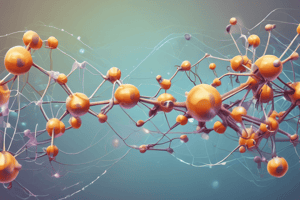Podcast
Questions and Answers
Describe the structure of a nucleotide
Describe the structure of a nucleotide
A nucleotide consists of a sugar (deoxyribose), one of four bases (Cytosine, Thymine, Adenine, Guanine), and a phosphate.
Explain how nucleotides are arranged to make up a polynucleotide
Explain how nucleotides are arranged to make up a polynucleotide
Through a covalent bond between the phosphate group of one, and the third carbon atom of the pentose sugar in the next.
Name the four nucleotides found in DNA and explain how they differ
Name the four nucleotides found in DNA and explain how they differ
Cytosine, thymine, adenine, and guanine. They differ in their nitrogen-containing bases.
Give the two differences between DNA and RNA
Give the two differences between DNA and RNA
Describe the double-stranded helix of a DNA molecule
Describe the double-stranded helix of a DNA molecule
Explain how the replication of DNA depends on specific base pairing
Explain how the replication of DNA depends on specific base pairing
What are the two main stages of protein synthesis?
What are the two main stages of protein synthesis?
Describe transcription
Describe transcription
Describe translation
Describe translation
Explain how genetic info is written as codons and translated into amino acid sequences
Explain how genetic info is written as codons and translated into amino acid sequences
Explain how transcription produces genetic messages in the form of RNA
Explain how transcription produces genetic messages in the form of RNA
Describe the role of mRNA in getting the genetic message translated to the cytoplasm
Describe the role of mRNA in getting the genetic message translated to the cytoplasm
Explain the role of transfer RNA in the translation into polypeptides
Explain the role of transfer RNA in the translation into polypeptides
Describe the structure and the role of ribosomes in the synthesis of polypeptides
Describe the structure and the role of ribosomes in the synthesis of polypeptides
Define mutagen and explain how mutation can change the meaning of genes
Define mutagen and explain how mutation can change the meaning of genes
Define emerging viruses and give several examples
Define emerging viruses and give several examples
Describe a bacterial plasmid and explain how it can serve as a carrier for gene transfer
Describe a bacterial plasmid and explain how it can serve as a carrier for gene transfer
Describe recombinant DNA technology
Describe recombinant DNA technology
Identify the steps in gene cloning
Identify the steps in gene cloning
Explain how enzymes are used to 'cut and paste' DNA
Explain how enzymes are used to 'cut and paste' DNA
Define DNA ligase
Define DNA ligase
Flashcards are hidden until you start studying
Study Notes
Structure of Nucleotides
- Nucleotides are composed of three components: a sugar (deoxyribose), a phosphate group, and one of four nitrogenous bases (Cytosine, Thymine, Adenine, Guanine).
Formation of Polynucleotides
- Polynucleotides form through covalent bonds between the phosphate group of one nucleotide and the third carbon atom of the pentose sugar of the next nucleotide.
Nucleotide Variations in DNA
- DNA contains four nucleotides: Cytosine, Thymine, Adenine, and Guanine, which differ in their nitrogenous bases.
DNA vs. RNA
- DNA has deoxyribose sugar and bases A, T, C, G; RNA has ribose sugar and bases A, U, C, G.
Structure of DNA
- DNA molecules have a double-stranded helical structure, resembling a twisted ladder.
DNA Replication and Base Pairing
- DNA replication relies on base pairing: Adenine pairs with Thymine, and Cytosine pairs with Guanine, leading to the creation of daughter DNA.
Stages of Protein Synthesis
- Protein synthesis consists of two main stages: transcription and translation.
Transcription Process
- Transcription involves synthesizing RNA from a DNA template.
Translation Process
- Translation synthesizes polypeptides using genetic information encoded in mRNA.
Codons and Amino Acids
- Codons are triplet sequences of bases that correspond to specific amino acids, converting genetic information into protein sequences.
Role of mRNA
- mRNA carries genetic information from DNA to the cytoplasm, where it is translated into polypeptides.
Function of Transfer RNA (tRNA)
- tRNA translates codons in mRNA into corresponding amino acids during protein synthesis.
Ribosomes in Polypeptide Synthesis
- Ribosomes consist of two subunits made of proteins and ribosomal RNA, coordinating mRNA and tRNA to facilitate polypeptide synthesis.
Mutagens and Gene Mutation
- Mutagens are agents that cause mutations by altering DNA. Mutations can change genes and affect amino acid sequences.
Emerging Viruses
- Emerging viruses are newly identified or sudden viruses of interest to scientists, including HIV, H1N1, Ebola, West Nile Virus, and SARS.
Bacterial Plasmids
- Plasmids are small, independent DNA molecules in bacteria that can carry genes and facilitate gene transfer, such as the F factor associated with sex pili.
Recombinant DNA Technology
- Recombinant DNA technology combines DNA from different species in vitro for various applications.
Steps in Gene Cloning
- Key steps in gene cloning include isolating desired DNA, attaching it to a plasmid, introducing it into bacteria, growing the bacterial culture, and eventually integrating it into host cell DNA for observation of changes.
Cutting and Pasting DNA with Enzymes
- Restriction enzymes cut DNA at specific sites, creating sticky ends that allow different DNA fragments to join together. DNA ligase then covalently bonds these fragments permanently.
Role of DNA Ligase
- DNA ligase is crucial for DNA replication and genetic engineering, facilitating the bonding of adjacent DNA strands and aiding in the integration of new genes into plasmids.
Studying That Suits You
Use AI to generate personalized quizzes and flashcards to suit your learning preferences.




